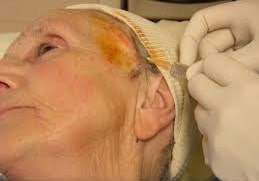Temporal artery biopsy
What is temporal artery biopsy and when is it needed?
 A medical procedure called a temporal artery biopsy involves taking a small sample of tissue from the temporal artery to be analyzed under a microscope. Giant cell arteritis, an inflammatory disease that affects the arteries of the head and neck, may require this procedure.
A medical procedure called a temporal artery biopsy involves taking a small sample of tissue from the temporal artery to be analyzed under a microscope. Giant cell arteritis, an inflammatory disease that affects the arteries of the head and neck, may require this procedure.
How is the temporal artery biopsy procedure carried out and what are its objectives?
Here are some details about the temporal artery biopsy process:
The temporal artery is biopsyed under local anesthesia.
Once the local anesthetic has been administered, a short incision is made directly over the artery and a segment of at least 2.5 cm of artery is excised.
The patient can go home the same day after the procedure, which can be performed on an outpatient basis.
Temporal artery biopsy results can help in the diagnosis of the inflammatory disease known as Giant cell arteritis, which affects the arteries of the head and neck.
If the temporal artery biopsy results are positive and there are signs of arteritis giant cell, the patient may require treatment with steroids to reduce inflammation.
The patient may not require further treatment if the temporal artery biopsy results are negative, c That is, there are no signs of giant cell arteritis.
What are the indications for temporal artery biopsy in the diagnosis of vascular disorders?
Diagnosis of giant cell arteritis: Temporal artery biopsy is often used to diagnose giant cell arteritis , which can cause headaches, jaw pain and vision loss. A biopsy takes a sample of tissue from the temporal artery to analyze it under a microscope to determine the presence of signs of inflammation.
Assessment of artery inflammation: Temporal artery biopsy can also be used to assess inflammation arteries in other vascular diseases, such as Takayasu disease and Horton disease.
What are the possible results of a temporal artery biopsy and how are they interpreted?
Here are the possible results of a temporal artery biopsy and their interpretation:
Positive result: if the tissue sample taken during the temporal artery biopsy shows signs of inflammation, this may indicate the presence of giant cell arteritis or another inflammatory disease of the blood vessels. In this case, the patient may require treatment with steroids to reduce inflammation.
Negative result: if the tissue sample taken during the temporal artery biopsy does not show signs inflammation, this may indicate the absence of giant cell arteritis or other inflammatory blood vessel diseases. In this case, the patient may not require additional treatment.
False negative: in rare cases, temporal artery biopsy may give a negative result even though the patient has signs of giant cell arteritis or other inflammatory blood vessel diseases. In this case, the patient may require additional tests to confirm the diagnosis.
What are the potential risks and complications associated with this procedure?
Temporary or permanent nerve damage to the temporal branch of the facial nerve, especially in deep biopsy.
Infection.
Hematoma.
Facial paralysis.
Cutaneous necrosis.
Cerebrovascular accident (CVA) or transient ischemic attack (TIA), although these complications are very rare.
What is the follow-up process after a temporal artery biopsy?
Follow-up after a temporal artery biopsy may vary depending on the nature of the disease and the results of the analysis. Here is some general information about follow-up after a temporal artery biopsy:
Temporal artery biopsy results may take several days or weeks.
If the results of the temporal artery biopsy are positive, i.e. it is If there are signs of giant cell arteritis or other inflammatory blood vessel diseases, the patient may require treatment with steroids to reduce the inflammation.
If the results of the temporal artery biopsy are negative, i.e. there are no signs of giant cell arteritis or other inflammatory blood vessel diseases, the patient may not require additional treatment.
Patients should discuss temporal artery biopsy results and treatment options available for their illness.
Patients may require regular follow-up exams to monitor disease progression and the effectiveness of treatment.